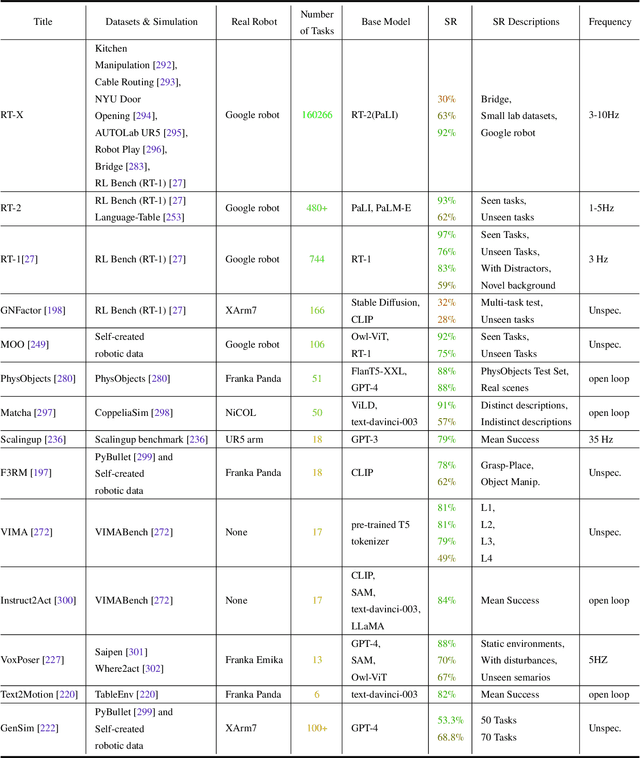Quanting Xie
Embodied-RAG: General non-parametric Embodied Memory for Retrieval and Generation
Sep 26, 2024



Abstract:There is no limit to how much a robot might explore and learn, but all of that knowledge needs to be searchable and actionable. Within language research, retrieval augmented generation (RAG) has become the workhouse of large-scale non-parametric knowledge, however existing techniques do not directly transfer to the embodied domain, which is multimodal, data is highly correlated, and perception requires abstraction. To address these challenges, we introduce Embodied-RAG, a framework that enhances the foundational model of an embodied agent with a non-parametric memory system capable of autonomously constructing hierarchical knowledge for both navigation and language generation. Embodied-RAG handles a full range of spatial and semantic resolutions across diverse environments and query types, whether for a specific object or a holistic description of ambiance. At its core, Embodied-RAG's memory is structured as a semantic forest, storing language descriptions at varying levels of detail. This hierarchical organization allows the system to efficiently generate context-sensitive outputs across different robotic platforms. We demonstrate that Embodied-RAG effectively bridges RAG to the robotics domain, successfully handling over 200 explanation and navigation queries across 19 environments, highlighting its promise for general-purpose non-parametric system for embodied agents.
Toward General-Purpose Robots via Foundation Models: A Survey and Meta-Analysis
Dec 15, 2023



Abstract:Building general-purpose robots that can operate seamlessly, in any environment, with any object, and utilizing various skills to complete diverse tasks has been a long-standing goal in Artificial Intelligence. Unfortunately, however, most existing robotic systems have been constrained - having been designed for specific tasks, trained on specific datasets, and deployed within specific environments. These systems usually require extensively-labeled data, rely on task-specific models, have numerous generalization issues when deployed in real-world scenarios, and struggle to remain robust to distribution shifts. Motivated by the impressive open-set performance and content generation capabilities of web-scale, large-capacity pre-trained models (i.e., foundation models) in research fields such as Natural Language Processing (NLP) and Computer Vision (CV), we devote this survey to exploring (i) how these existing foundation models from NLP and CV can be applied to the field of robotics, and also exploring (ii) what a robotics-specific foundation model would look like. We begin by providing an overview of what constitutes a conventional robotic system and the fundamental barriers to making it universally applicable. Next, we establish a taxonomy to discuss current work exploring ways to leverage existing foundation models for robotics and develop ones catered to robotics. Finally, we discuss key challenges and promising future directions in using foundation models for enabling general-purpose robotic systems. We encourage readers to view our living GitHub repository of resources, including papers reviewed in this survey as well as related projects and repositories for developing foundation models for robotics.
Reasoning about the Unseen for Efficient Outdoor Object Navigation
Sep 18, 2023Abstract:Robots should exist anywhere humans do: indoors, outdoors, and even unmapped environments. In contrast, the focus of recent advancements in Object Goal Navigation(OGN) has targeted navigating in indoor environments by leveraging spatial and semantic cues that do not generalize outdoors. While these contributions provide valuable insights into indoor scenarios, the broader spectrum of real-world robotic applications often extends to outdoor settings. As we transition to the vast and complex terrains of outdoor environments, new challenges emerge. Unlike the structured layouts found indoors, outdoor environments lack clear spatial delineations and are riddled with inherent semantic ambiguities. Despite this, humans navigate with ease because we can reason about the unseen. We introduce a new task OUTDOOR, a new mechanism for Large Language Models (LLMs) to accurately hallucinate possible futures, and a new computationally aware success metric for pushing research forward in this more complex domain. Additionally, we show impressive results on both a simulated drone and physical quadruped in outdoor environments. Our agent has no premapping and our formalism outperforms naive LLM-based approaches
 Add to Chrome
Add to Chrome Add to Firefox
Add to Firefox Add to Edge
Add to Edge